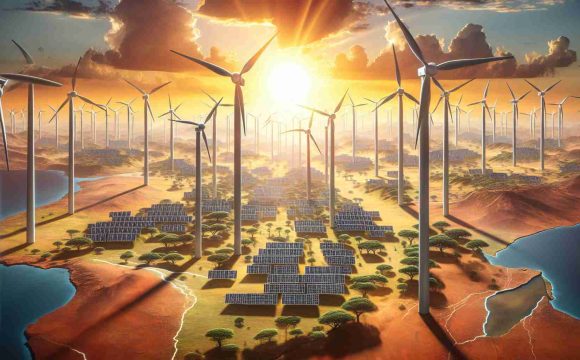- Wichita County’s skyline is set for transformation with a new 800-acre solar and battery farm in Burkburnett, promoting renewable energy.
- The project, led by Nymphaea Solar, a Samsung affiliate, starts in 2027 and will be operational by mid-2028, powering thousands of homes.
- County commissioners have approved a reinvestment zone, signaling the start of Wichita County’s shift to sustainability.
- The project’s property tax value boost, between $190-$200 million, sparks economic interest and recalibration of local financial forecasts.
- Local leaders aim for inclusion and transparency as the project promises jobs and economic activity during its construction phase.
- Community engagement and collaboration with city and school officials are key as Texas embraces a sustainable future.
Wichita County heats up with anticipation as a colossal new project promises to transform the Burkburnett area skyline and propel it into a sustainable future. The sprawling landscape, soon to be a bustling hub of renewable energy, will house an extraordinary solar and battery farm spanning 800 acres—a vital step toward a greener Texas.
This ambitious endeavor, brought to life by Nymphaea Solar, a Samsung affiliate, is poised to break ground in early 2027. Once operational by mid-2028, this plant will weave a transformative tapestry of sunlight and innovation, generating power for tens of thousands of homes. Tucked neatly east of Interstate Highway 44, near the quaint town of Burkburnett, rows of solar panels will stand shoulder to shoulder in harmony with the land, diligently harnessing the Texas sun.
County commissioners have embraced this leap toward sustainability by approving a reinvestment zone, igniting the initial spark for this renewable revolution. As anticipation builds for further collaborative discussions, city and school officials seek a coveted seat at the table. The remarkable escalation in property tax value promises a handsome figure between $190-$200 million, offering both hope and a hint of contention as local districts recalibrate financial forecasts.
While the monumental project leaves local leaders seeking inclusion and transparency, the community can expect an economic pulse during its construction phase, employing hundreds in a hard-fought quest for sustainable progress.
Texas stands ready, poised for a metamorphosis where solar splendor and ingenuity illuminate a path toward a brighter, greener tomorrow. Whether you’re a longtime Texan or a curious observer, remember that in Wichita County, change is on the horizon, brilliantly powered by the relentless sun.
Revolutionizing Wichita County: Everything You Need to Know About the New Solar and Battery Farm
How-To Steps & Life Hacks: Setting Up Your Own Solar Power System
1. Assess Your Energy Needs: Calculate the total wattage required for your household by examining your utility bills and considering your power usage trends.
2. Choose the Right Location: Find the optimal position for the solar panels—ideally, where they can capture maximum sunlight throughout the day. This is crucial for maximizing efficiency.
3. Select Your Equipment: Invest in high-quality solar panels, an inverter, batteries for storage, and a solar charge controller. Be sure the components are compatible and appropriately sized for your energy needs.
4. Installation: Hire certified professionals for installation to ensure safety and adherence to local building codes. DIY installations are possible but not recommended for beginners.
5. Connect to the Grid or Go Off-Grid: Decide whether you want to supplement your energy usage by connecting to the grid or develop a completely off-grid system. Each option has its benefits and challenges.
6. Maintenance: Regularly clean the solar panels and check the systems for optimal performance. Seasonal checks are advisable for long-term efficiency.
Real-World Use Cases: Transformative Impact of Solar Farms
– Energy Independence: Solar farms like the one in Wichita County help communities reduce dependency on fossil fuels, increase energy security, and insulate themselves from volatile energy markets.
– Economic Growth: During the construction phase, solar farms create a substantial number of jobs and stimulate local economies, as seen in the Burkburnett area.
– Educational Opportunities: Schools in the region can use the solar farm project as an educational tool, integrating renewable energy topics into their curriculum and fostering interest in STEM careers.
Market Forecasts & Industry Trends
The global solar power market is expected to continue its upward trajectory, with a compound annual growth rate (CAGR) of about 20% through the next decade. Adoption is driven by decreasing technology costs, government incentives, and increased demand for clean energy sources.
In Texas, the solar market is booming due to its abundant sunshine and favorable regulatory environment. The state is projected to become one of the leading solar power producers in the U.S., with significant investments accelerating this transition.
Controversies & Limitations
– Land Use Conflicts: Solar farms often face opposition due to land use concerns, including the potential impact on local agriculture and ecosystems.
– Intermittency Issues: Solar energy is weather-dependent. Effective energy storage solutions, like the battery system in the Wichita County project, are essential to overcoming intermittency.
Features, Specs & Pricing: The Nymphaea Solar Project
– Size: The solar farm will cover 800 acres, illustrating the scale required to produce substantial power for tens of thousands of households.
– Infrastructure: State-of-the-art solar panels and a robust battery storage system will ensure continuous power delivery even during cloudy days or peak usage times.
– Costs: Initial investments typically run in the hundreds of millions. Specific pricing depends on various factors, including technology choice and project duration.
Security & Sustainability
The project promises enhanced energy security by diversifying the energy supply mix, reducing vulnerability to price spikes and market volatility. Its sustainable design ensures minimal environmental impact, supporting biodiversity by maintaining undeveloped land around the solar installations.
Pros & Cons Overview
Pros
– Environmental Benefits: Reduces carbon emissions and reliance on fossil fuels.
– Economic Growth: Provides jobs and increases local economic activity.
– Energy Independence: Enhances energy security and autonomy.
Cons
– Initial Costs: High upfront investment required.
– Land Use: Potential conflicts with existing land purposes.
– Weather Dependency: Energy production varies with weather conditions.
Actionable Recommendations:
– Community Engagement: Join local discussions to understand the project’s impact and benefits thoroughly. Stay informed and participate in town hall meetings.
– Incorporate Solar Power: If inspired by this large-scale project, consider installing solar panels at home to benefit from clean energy and reduce electricity bills.
For more information on solar energy and innovative projects, consider visiting U.S. Department of Energy.
By harnessing the power of the sun, Wichita County is on the verge of a green transformation, promising a sustainable and economically vibrant future. Whether you’re in Texas or beyond, the lessons from this ambitious project offer a glimpse into a cleaner tomorrow.






